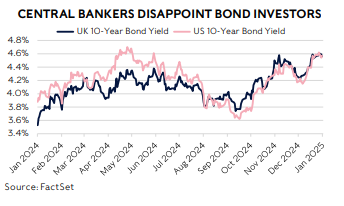
Back on the carousel
AFTER A SOLID YEAR FOR INVESTORS, ALBEIT WITH JARRING MOMENTS AND A PERVASIVE UNCERTAINTY, WHAT DOES 2025 HAVE IN STORE?
Another solid year is in the bag for investors, although you’re forgiven if it hasn’t felt like it! Inflation continues to lurk in the wings, economic growth in most places looks patchy (apart from the US), and global politics is a carnival carousel – and not one of the good ones. More like a rickety, rusty sort of contraption set up by night in the common. You know the ones…
In short, the past five years as a whole has tended to be good for investors, but individual days, weeks and months can be jarring or downright scary. Twenty Twenty-Four was no different.
In its last meeting of 2024, the US Federal Reserve (Fed) cut its benchmark overnight interest rate by a quarter of a percentage point to the range of 4.25-4.50%. That took the total of the year’s rate cuts to 1%. While that Christmas present was so widely expected that it didn’t need wrapping, Fed Chair Jay Powell was more Grinchy about the future than investors had hoped. There may not be more rate cuts for a while – or at least, fewer than people hope. That led to a sell-off in US government bonds which took most other government bonds with them.
This meant the Bloomberg Global Aggregate bond market index fell to a 1.7% loss for 2024, the third in four years. That sustained poor run is unprecedented in the past 30 years. An especially disappointing result in a year of steadily falling interest rates – you would have expected bonds to do well in such an environment – and they had until the tail end of the year. Instead, bond investors are focused on a future where benchmark interest rates are higher than they would like, rather than enjoying the reduction in rates today.

When bond prices fall, the yields they offer rise. This usually affects stock prices as well because higher ‘risk-free’ returns from government bonds make their prospective returns that much less attractive. And so it was in December: as yields rose stocks generally fell back. Despite this dampened end, 2024 was another strong year for stock markets. It was another spectacular year for the US, which notched up a gain of more than 20% for the second year running. And, it wasn’t just the Magnificent Seven tech companies at the top of the S&P 500 either.
Here in the UK, equity gains were much lower than the stonking returns across the Atlantic, but a 9% return is perfectly decent when compared to history. Unfortunately, the economy is much ropier. Since the new government took power in July, growth has bled away, hitting 0% in the third quarter. This malaise was reflected in a precipitous drop in Citigroup’s UK Economic Surprise Index, a measure of economic data releases against analysts’ expectations. It fell from +66 to -45.
If there’s any consolation, it tends not to fall much further than this, other than in extreme circumstances such as the Global Financial Crisis or the COVID pandemic. It has since improved slightly. The reluctance of the Bank of England to continue cutting interest rates in the face of sticky service sector inflation is also something of a hindrance. Any signs that inflation is abating faster could give UK equities a boost, especially the more domestically focused small and mid-cap companies. We believe there’s good value in the UK for long-term holders, despite the current mood. And so, it seems, do corporate buyers if we consider the pickup in mergers and acquisitions (M&A) over the past year.
So where next?
One of the major drivers of calm or concern in global markets will be the path of US interest rates. If they fall faster than expected – and the moves aren’t a reaction to a bad deterioration in the American economy – investors are likely to relax, benefiting both stocks and bonds. If inflation forces the Fed to keep rates where they are – or increase them again – all sorts of concerns will tumble out and markets will get very choppy indeed.
The US economy will be a big part of that equation. If it has the people, tools and funds to grow solidly without sparking inflation, and it isn’t hit with a downturn, we believe it should deliver another great year for stocks. Of course, that could be upended by the incoming Trump administration, which was elected on a platform of protectionism, severely curtailed immigration and looser regulations. We will have to see what happens, but – as we saw in his first term – rhetoric doesn’t always align to action. Sometimes he’s rattling cages for effect. That’s how most investors appear to have taken Donald Trump’s win: US stocks soared in the aftermath of the November election.
A year ago, investors expected that US rates would be roughly half a percentage point lower today than where they are now. That was always a heroic assumption: possible, but unlikely. At the time, many investors expected the US economy to run out of steam. It didn’t. The economy barrelled along at the same pace of roughly 3%. In that context, you could argue that it’s a better result: inflation is slightly higher than forecast and rates are moderately higher than hoped, but the US economy is much bigger than expected and Americans are wealthier.
This also shows how difficult it is to predict the path of economies, rates and markets. We simply don’t know what the future holds. Yet because many investors do overestimate their prescience and often in an erratic fashion, it can produce mispricing and opportunities for investors who are patient enough to look through the ups and downs. What we see today is probably not going to be what we see in another year’s time. The mood can shift quickly.
The views in this update are subject to change at any time based upon market or other conditions and are current as of the date posted. While all material is deemed to be reliable, accuracy and completeness cannot be guaranteed.
This document was originally published by Rathbone Investment Management Limited. Any views and opinions are those of the author, and coverage of any assets in no way reflects an investment recommendation. The value of investments and the income from them may go down as well as up and you may not get back your original investment. Fluctuations in exchange rates may increase or decrease the return on investments denominated in a foreign currency. Commissions, trailing commissions, management fees and expenses all may be associated with mutual fund investments. Please read the prospectus before investing. Mutual funds are not guaranteed, their values change frequently, and past performance may not be repeated.
Certain statements in this document are forward-looking. Forward-looking statements (“FLS”) are statements that are predictive in nature, depend upon or refer to future events or conditions, or that include words such as “may,” “will,” “should,” “could,” “expect,” “anticipate,” “intend,” “plan,” “believe,” or “estimate,” or other similar expressions. Statements that look forward in time or include anything other than historical information are subject to risks and uncertainties, and actual results, actions or events could differ materially from those set forth in the FLS. FLS are not guarantees of future performance and are by their nature based on numerous assumptions. The reader is cautioned to consider the FLS carefully and not to place undue reliance on FLS. Unless required by applicable law, it is not undertaken, and specifically disclaimed that there is any intention or obligation to update or revise FLS, whether as a result of new information, future events or otherwise.
